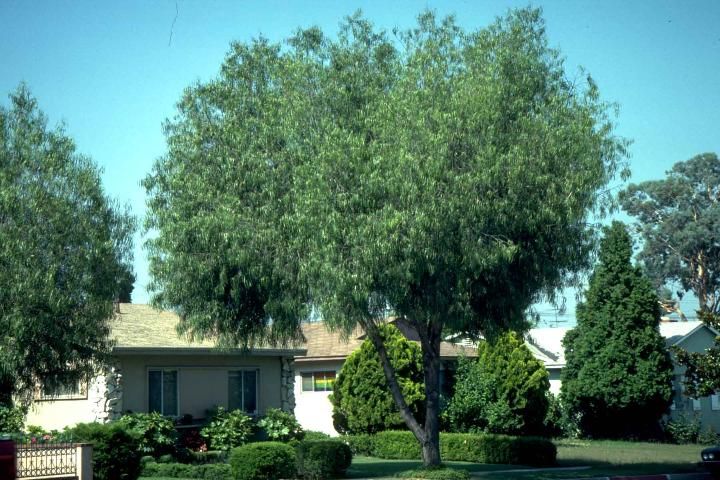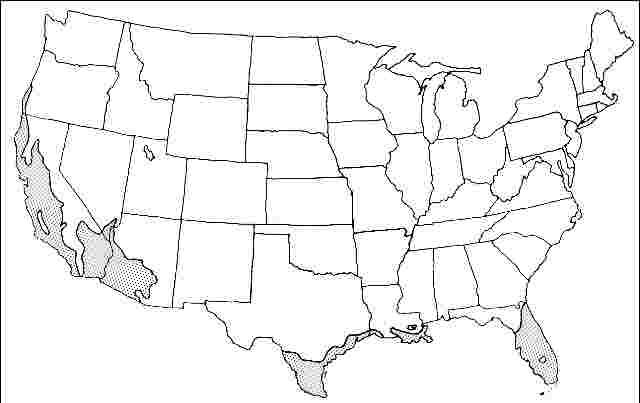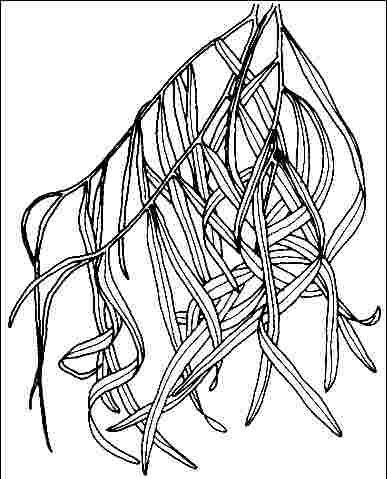Introduction
Australian-Willow is an attractive evergreen, 30 to 35 feet tall and 20 feet wide, with an upright, oval silhouette. The main inner branches are composed of strong, wind-resistant wood and are directed upward, while the outer smaller branches are somewhat pendulous. This gives a decided weeping habit to older trees. Younger trees are more oval-shaped. This characteristic, combined with the thin, narrow, three to six-inch-long, olive green leaves which droop from the branches, gives the tree much the same effect as a Weeping Willow. Short panicles of small, creamy white, showy flowers appear in early spring and early fall.

Credit: Ed Gilman
General Information
Scientific name: Geijera parviflora
Pronunciation: gay-JEER-uh par-vih-FLOR-uh
Common name(s): Australian-Willow
Family: Rutaceae
USDA hardiness zones: 9A through 11 (Fig. 2)
Origin: not native to North America
Uses: deck or patio; shade; specimen; street without sidewalk; screen; parking lot island < 100 sq ft; parking lot island 100-200 sq ft; parking lot island > 200 sq ft; tree lawn 3-4 feet wide; tree lawn 4-6 feet wide; tree lawn > 6 ft wide
Availability: not native to North America

Description
Height: 30 to 35 feet
Spread: 20 to 25 feet
Crown uniformity: symmetrical
Crown shape: weeping, round, oval
Crown density: dense
Growth rate: fast
Texture: fine
Foliage
Leaf arrangement: alternate (Fig. 3)
Leaf type: simple
Leaf margin: entire
Leaf shape: lanceolate, linear
Leaf venation: pinnate
Leaf type and persistence: evergreen
Leaf blade length: 2 to 4 inches
Leaf color: green
Fall color: no color change
Fall characteristic: not showy

Flower
Flower color: white/cream/gray
Flower characteristics: showy
Fruit
Fruit shape: round, irregular
Fruit length: .5 to 1 inch
Fruit covering: dry or hard
Fruit color: unknown
Fruit characteristics: does not attract wildlife; not showy; fruit/leaves not a litter problem
Trunk and Branches
Trunk/bark/branches: branches droop; not showy; typically one trunk; thorns
Pruning requirement: needed for strong structure
Breakage: resistant
Current year twig color: green
Current year twig thickness: thin
Wood specific gravity: unknown
Culture
Light requirement: full sun
Soil tolerances: sand; loam; acidic; slightly alkaline; well-drained
Drought tolerance: moderate
Aerosol salt tolerance: moderate
Other
Roots: not a problem
Winter interest: no
Outstanding tree: yes
Invasive potential: little invasive potential
Ozone sensitivity: unknown
Verticillium wilt susceptibility: unknown
Pest resistance: free of serious pests and diseases
Use and Management
Australian-Willow casts a light shade and is ideal for use around a patio or as a lawn specimen, but may be too weeping for use as a street tree unless it is properly trained when it is young. If the lowest main limbs are located high enough above the ground and are oriented in an upright-spreading fashion, then there will be clearance even for large trunks. Only small branches may have to be removed later as they droop from the main limbs toward the ground. Otherwise the tree has very good cultural adaptability to urban spaces.
Australian-Willow will give best growth in full sun on moist but well-drained soil although plants can tolerate light shade and very dry conditions. Trees grown in the open very rarely require any pruning if located where the drooping branches will not interfere with traffic below. A popular tree for the dry southwest, not really known or planted in the East.
Propagation is by seed.
Pests and Diseases
No pests or diseases are of major concern. Root rot may be a problem on sites without excellent drainage.
